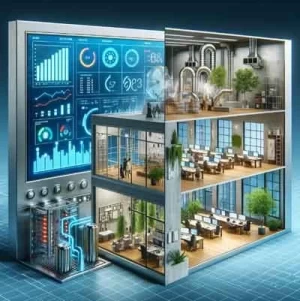Powering Efficiency: BAS and the Pursuit of Sustainable Buildings

Building Automation Systems (BAS) have revolutionized how buildings operate, transforming them from static structures into dynamic environments that can adapt to changing needs. One of the most compelling applications of BAS lies in its ability to optimize energy consumption, contributing significantly to the growing demand for sustainable buildings. This article explores how BAS contribute to energy efficiency by automating various building systems and examines the benefits, technical considerations, and potential limitations of this approach.
Visit Our Building Automation Study Course
Unlocking Efficiency: Benefits of BAS for Energy Optimization
BAS empower building owners and managers to achieve significant energy savings through automated control strategies. These benefits include:
Automated HVAC Optimization: BAS continuously monitor temperature and humidity conditions within a building. This allows for automatic adjustments to HVAC systems based on occupancy patterns and real-time needs. For example, BAS can automatically lower heating or cooling setpoints during unoccupied periods or adjust airflow based on real-time temperature readings.
Lighting Control: BAS can be integrated with occupancy sensors to enable automatic lighting control. Lights can be automatically turned off in unoccupied spaces, leading to significant reductions in lighting energy consumption. Additionally, BAS can dim lights based on natural daylight availability, further optimizing lighting usage.
Demand Response Management: BAS can participate in demand response programs offered by utilities. These programs allow buildings to reduce energy consumption during peak demand periods in exchange for financial incentives. BAS facilitate this by automatically adjusting building systems (e.g., temporarily raising room temperature) to lower energy demand during peak hours.
Equipment Optimization: BAS monitor equipment performance and identify inefficiencies. This allows for preventive maintenance, reducing equipment downtime and ensuring optimal energy usage. Additionally, BAS can be used to optimize equipment operation based on real-time conditions. For example, variable speed drives can be used for fans and pumps, allowing BAS to adjust their speed based on demand, leading to lower energy consumption.
Data-Driven Insights: BAS collect vast amounts of data on energy consumption and building performance. This data can be analyzed to identify areas for further improvement and inform energy-saving strategies. Building managers can use this data to adjust control settings, optimize equipment operation schedules, and identify potential energy leaks.
Technical Considerations for Building Energy Efficiency with BAS
Several technical aspects need consideration when implementing BAS for energy optimization:
System Design: Effective BAS design requires careful consideration of building characteristics, occupancy patterns, and energy-saving goals. Choosing the right sensors, actuators, and control algorithms is crucial for achieving optimal efficiency.
Integration with Existing Systems: For existing buildings, BAS need to be seamlessly integrated with existing HVAC, lighting, and other building systems. This might necessitate upgrades to existing equipment or communication protocols to ensure efficient data exchange.
Communication Network: A reliable communication network is essential for real-time data exchange between BAS components. Choosing the right network infrastructure (wired or wireless) depends on building size, layout, and desired level of control.
Interoperability: BAS components from different manufacturers should communicate seamlessly. Open protocols like BACnet or Modbus are preferred to ensure interoperability and future expandability of the BAS system.
Cybersecurity: As BAS collect sensitive data on energy consumption and building operations, robust cybersecurity measures are essential. Implementing firewalls, secure access controls, and regularly updating software patches are crucial for protecting BAS from cyberattacks.
Limitations and Challenges: Navigating the Path to Efficiency
While BAS offer significant benefits, some limitations require consideration:
Initial Investment Costs: Implementing a BAS can involve significant upfront costs for hardware, software, and installation. However, these costs can be offset by long-term energy savings and potential utility incentives.
Complexity of Systems: BAS can be complex systems to design, install, and maintain. Technical expertise is often required to ensure optimal operation and achieve desired energy savings.
User Training: Building occupants need training on how to operate BAS features like occupancy sensors or lighting controls. This ensures that occupants contribute to energy-efficient building operation.
Occupancy Patterns: BAS effectiveness relies heavily on understanding and predicting occupancy patterns. In buildings with unpredictable occupancy, achieving optimal energy efficiency might be more challenging.
The Road to a Sustainable Future
BAS are powerful tools for promoting energy efficiency and contributing to a more sustainable built environment. By optimizing building operations and providing valuable data insights, BAS empower building owners and managers to make informed decisions that reduce energy consumption and lower operational costs. Additionally, BAS contribute to sustainability by minimizing equipment waste and promoting environmentally friendly practices.
Emerging Trends and the Future
Integration with IoT Devices: The integration of BAS with Internet of Things (IoT) devices like smart thermostats and occupancy sensors can further enhance energy-saving capabilities through hyper-local control and real-time data collection.
Machine Learning and AI: Machine learning algorithms can analyze historical energy consumption data and identify patterns to predict future energy needs. This allows for proactive optimization of BAS control strategies and even predictive maintenance for building systems.
Cloud-based BAS: Cloud-based BAS solutions offer scalability, remote access, and easier data management. This facilitates centralized control and monitoring of multiple buildings, further enhancing energy performance across portfolios.
A Collaborative Approach: Building a Sustainable Future Together
Building a truly sustainable future with energy-efficient buildings requires a collaborative approach involving several stakeholders:
Building Owners and Facility Managers: Investing in BAS and promoting energy-saving practices within their buildings demonstrates a commitment to sustainability. Implementing building energy audits and benchmarking against industry standards can help identify areas for improvement.
System Integrators: System integrators play a crucial role in designing, installing, and maintaining BAS. Their expertise in integrating BAS with existing systems and selecting the right technologies ensures optimal performance and energy savings.
Energy Efficiency Consultants: Energy efficiency consultants can provide valuable expertise in optimizing BAS control strategies and developing data-driven energy management plans.
Policymakers: Government policies that promote energy efficiency and provide incentives for BAS implementation can encourage wider adoption and accelerate the transition to sustainable buildings.
Building a Future of Efficiency and Sustainability
Building Automation Systems are not just about convenience; they are powerful tools for optimizing energy consumption and promoting a more sustainable built environment. By harnessing the power of automation, data analytics, and collaboration, stakeholders can create intelligent buildings that are not only energy-efficient but also comfortable, productive, and environmentally responsible. Building a future of efficient BAS operation combined with responsible occupant behavior will pave the way for a more sustainable future for our cities and the planet.









